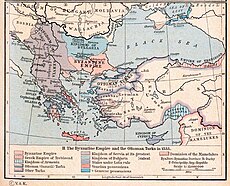
Back Аўстрыйская вайсковая мяжа Byelorussian Вайсковая мяжа BE-X-OLD Военна граница Bulgarian Vojenská hranice Czech Militærgrænsen Danish Militärgrenze German Limgarda zono Esperanto Frontera Militar Spanish Sõjaväestatud piiriala Estonian مرز نظامی Persian
This article includes a list of general references, but it lacks sufficient corresponding inline citations. (April 2009) |
Military Frontier Militärgrenze (German) | |
|---|---|
| 1553–1881 | |
 Map of the Military Frontier (marked with a red outline) in 1800 | |
| Status | Military province |
| Religion | Catholic Church Eastern Orthodox Church |
| Historical era | Early Modern period |
• Established | 1553 |
• Disestablished | 1881 |
| History of Austria |
|---|
 |
|
|
| History of Croatia |
|---|
 |
| Timeline |
|
|
| History of Hungary |
|---|
 |
|
|
| History of Serbia |
|---|
 |
|
|
The Military Frontier (German: Militärgrenze; Serbo-Croatian: Војна крајина, Vojna krajina, Војна граница, Vojna granica; Hungarian: Katonai határőrvidék; Romanian: Graniță militară) was a borderland of the Habsburg monarchy and later the Austrian and Austro-Hungarian Empire. It acted as the cordon sanitaire against incursions from the Ottoman Empire.
The establishment of the new defense system in Hungary and Croatia took place in the 16th century, following the election of Ferdinand I as king. Six districts under special military administration were established in Hungary and Croatia. The Croatian Military Frontier and the Slavonian Military Frontier came under the jurisdiction of the Croatian Sabor and ban. In 1627, they were placed under the direct control of the Habsburg military. For more than two centuries, they would retain complete civilian and military authority over the area, up to the abolition of the Military Frontier in 1881.
During the 17th century, the territory was expanded towards the East and new sections were created. By then, it stretched from Croatia proper in the west to eastern Transylvania in the east and included parts of present-day Croatia, Bosnia and Herzegovina, Serbia, Romania and Hungary. During this period, the defence system was also changed, from a conventional garrison model to one of 'soldier-settler' communities.
The inhabitants of the area were known as the Grenzer (or frontiersmen). They were mostly Serbian, Croatian, German, Vlach and other colonists.[1][2][3][4][5][6][7][8][9][excessive citations] In exchange for land-grants, religious freedom and favorable tax rates, they colonized the area and served as the bulwark for the monarchy against Ottoman incursions. Germans had been recruited by Hungary in the late 18th century to resettle and develop the Danube River Valley, and became known as Donauschwaben. The military regiments formed by the settlers had a vested reason to stand and fight and were familiar with local terrain and conditions. They soon gained a formidable military reputation.
- ^ Frucht, Richard (2004). Eastern Europe, An Introduction to the People, Lands, and Culture. ABC-CLIO. p. 422. ISBN 1576078000.
- ^ Stoianovich, Traian (1992). Balkan Worlds: The First and Last Europe. Routledge. p. 152. ISBN 1563240335.
- ^ Hálfdanarson, Guðmundur (2003). Racial Discrimination and Ethnicity in European History. PLUS, Università di Pisa. ISBN 9788884922809.
- ^ Macartney, Carlile Aylmer, ed. (2017). Hungary: From Ninth Century Origins to the 1956 Uprising. Routledge. p. 116. ISBN 978-1138525542.
- ^ Malcolm, Noel (1996). Bosnia: A Short History. NYU Press. p. 98. ISBN 0814755615.
- ^ Pál, Fodor; Geza, David; Gábor, Agoston; Klára, Hegyi; József, Kelenik; Kybinyi, András [in Hungarian]; Géza, Pálffy (2000). Ottomans, Hungarians, and Habsburgs in Central Europe: The Military Confines in the Era of Ottoman Conquest (Ottoman Empire and Its Heritage). Brill. p. 62. ISBN 9004119078.
- ^ Calic, Marie-Janine [in German] (2019). The Great Cauldron: A History of Southeastern Europe. Harvard University Press. p. 79. ISBN 978-0674983922.
- ^ Banac, Ivo (1984). The National Question in Yugoslavia: Origins, History, Politics. Cornell University Press. p. 43. ISBN 0801416752.
- ^ Kaser, Karl (2012). Household and Family in the Balkans: Two Decades of Historical Family Research at University of Graz. LIT Verlag. pp. 123–124. ISBN 978-3643504067.
© MMXXIII Rich X Search. We shall prevail. All rights reserved. Rich X Search
